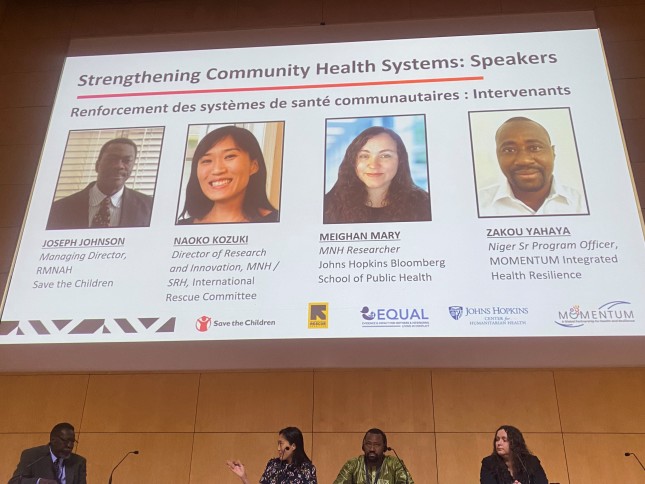-
Strengthening Community Health Systems to Improve MNH Outcomes at the Last Mile
July 26, 2023 By Alicia Adler
Advances in reducing maternal mortality were seen all over the world in recent decades. Unfortunately, that progress now has stagnated, and immediate and decisive action is necessary to change the current trajectory.
Despite improvements in access to and utilization of facility-based care, countries across sub-Saharan African lag far behind with nearly 60% of women giving birth at home without a skilled professional. The number is higher in humanitarian and fragile settings which contributes to the reality that countries with a 2023 UN Humanitarian Appeal account for nearly two-thirds of maternal deaths and one-half of newborn deaths and stillbirths. In Somalia and South Sudan for example, more than 80% of women give birth outside of a health facility, often without the support of a skilled health professional.
This pressing issue took center stage during the recent International Maternal and Newborn Health Conference held in Cape Town, South Africa. Over the course of the four-day conference, maternal and newborn health (MNH) actors shared the latest evidence, guidelines, and lessons learned from different contexts. Yet while a significant portion of the program focused on strengthening facility-based quality of care, there were a fewer number of sessions that underscored something equally important: strengthening community health systems.
Community health systems are comprised of various elements that work together to support and deliver primary healthcare services at the local level. Community Health Workers (CHWs) provide basic services and offer a link between the community and the formal health system, while health clinics deliver basic care like family planning and antennal care. Community health systems also feature outreach programs that bring services directly to remote areas, as well as health committees that mobilize community participation in the health system.
These components – among many others – are critical for bringing care closer to communities and reducing barriers to access. One panel discussion in Cape Town highlighted three different approaches for strengthening and expanding community health systems to improve MNH outcomes at the last mile.
“While investments in facility-based services and quality are paramount, the reality is we are off track to meet 2030 goals and we need to simultaneously focus on bringing life-saving care as close to women and babies as possible,” explained Dr. Naoko Kozuki, Director of Research and Innovation for Sexual, Reproductive, Maternal, and Neonatal Health at the International Rescue Committee (IRC).
Kozuki underscored how strengthening community health systems to deliver MNH services is key for reducing risk for millions of women and babies. It is also essential for enhancing preparedness and resilience before services are disrupted by crisis, conflict, and/or the mounting impacts of climate change.

Three Community-based Approaches in Action
The efforts to strengthen community health systems are happening in a number of places—as the panel’s three speakers demonstrated with their stories of putting this work into practice.
Dr. Meighan Mary, research faculty at Johns Hopkins Center for Humanitarian Health, pointed to the importance of having robust Maternal and Perinatal Death Surveillance and Response (MPDSR) systems that provide actionable data on maternal and perinatal mortality rates, causes, and underlying factors contributing to the deaths.
In her discussion, Dr. Mary introduced attendees to action-oriented research being led by the Catholic University of Bukavu (UCB) and Johns Hopkins Center for Humanitarian Health, who are partners in the EQUAL research consortium. Together, their research aims to assess the feasibility, acceptability, and effectiveness of community-based maternal and perinatal death surveillance in low-income, conflict-affected contexts, specifically in North and South Kivu, DRC. “In many contexts, we know that facility-level data represents only a part of the total cases of maternal and newborn births and deaths because cases at the community level are not always reported or investigated,” she explained.
Research is now underway in North and South Kivu to understand how information related to maternal and perinatal mortality is collected within the health sector, through various administrative systems, and at the community level. Leveraging how CHWs and other actors – like religious leaders, traditional birth attendants, and funeral personnel – support the identification, notification, and review (ex. verbal and social autopsy) of deaths within communities will play an essential role in delivering high-quality MNH services that meet the needs of each community.
Another study carried out under the EQUAL research consortium is a project being piloted by the IRC and the Somali Research and Development Institute (SORDI) in South Sudan and Somalia to design, test, and evaluate a community-based MNH care package that aligns with the specific needs of local partners and communities. Dr. Kozuki described this effort, and introduced the concept of constrained optimization – a mathematical modeling approach the IRC is using to help national stakeholders prioritize interventions.
“There is a tendency to take an ‘everything but the kitchen sink approach,’” explained Dr. Kozuki, “but this modeling is helping us to prioritize by considering local constraints like the cost of commodities and services, time and capacity of CHWs, bandwidth for training, existing policies, and more.” Coupled with recommendations from behavioral insights and user-centered design, the IRC will soon begin implementing a program that responds to the unique challenges women face in these settings.
Zakou Yahaya, Niger Senior Program Officer, MOMENTUM Integrated Health Resilience (MIHR), shared the adverse health outcomes resulting from limited access to facility-based services in Niger with the attendees. He noted that having recognized that post-partum hemorrhage (PPH) is a leading cause of maternal mortality, Niger’s Ministry of Health approved the advanced distribution of misoprostol for home deliveries, and yet uptake of this treatment remains low.
Zakou outlined an analysis recently conducted in Niger to evaluate the availability of misoprostol in health facilities, its utilization, and distribution for the prevention of PPH. The analysis identified numerous bottlenecks to uptake, including the lack of clear policies and guidelines at the national level, lack of training and awareness among health providers on the proper use of misoprostol for PPH, and fear of stigma around the use of misoprostol for other purposes including abortions.
“We are now using the findings to address the bottlenecks by continuing discussions on the regulatory and policy environment for misoprostol distribution and developing plans for engaging with communities and health providers to improve uptake for example through sensitization sessions with mothers’ groups,” observed Zakou.
The stories shared by the three panelists underscore not only the challenges in bolstering community health systems, but also the work being done now to make them more effective in delivering MNH care. As progress toward global MNH targets has stalled, and in some cases, in decline, increased investments are needed to strengthen this critical pathway to lifesaving care.
Alicia Adler is a Senior Research Uptake Advisor at the International Rescue Committee working as part of the EQUAL research consortium.
Sources: Align MNH, Equal Research, IMNHC, International Rescue Committee, Sordi, UNICEF, USAID MOMENTUM, World Health Organization.
Photo Credit: Hauwa Mustapha, 30, interacts with other women during mother-mother session within their community at Sulubri, Maiduguri, Borno, Nigeria. Photo by KC Nwakalor for IRC. In-text photo: Photo by Alicia Adler, IRC.
Note: Professor Pacifique Mwene-Batu from the Université Catholique de Bukavu was a selected speaker for this session but was unable to attend due to delays in visa processing.
 A Publication of the Stimson Center.
A Publication of the Stimson Center.




